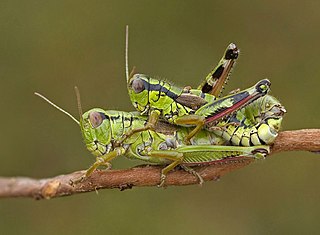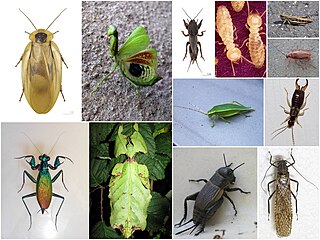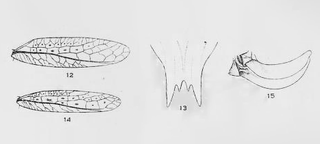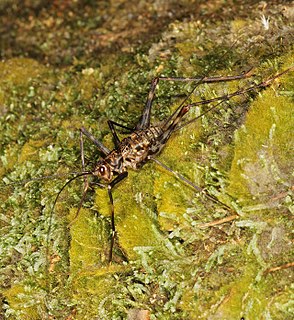Related Research Articles

Insects in the family Tettigoniidae are commonly called katydids, or bush crickets. They have previously been known as "long-horned grasshoppers". More than 6,400 species are known. Part of the suborder Ensifera, the Tettigoniidae are the only extant (living) family in the superfamily Tettigonioidea.

Orthoptera is an order of insects that comprises the grasshoppers, locusts and crickets, including closely related insects such as the katydids and wētā. The order is subdivided into two suborders: Caelifera – grasshoppers, locusts and close relatives; and Ensifera – crickets and close relatives.

Anostostomatidae is a family of insects in the order Orthoptera, widely distributed in the southern hemisphere. It is named Mimnermidae or Henicidae in some taxonomies, and common names include king crickets in South Africa and wētā in New Zealand. Prominent members include the Parktown prawn of South Africa, and the giant wētā of New Zealand. The distribution of this family reflects a common ancestry before the fragmenting of Gondwana.

Cooloola is a genus of ensiferan orthopterans known as Cooloola monsters. It is the only genus in the subfamily Cooloolinae and family Cooloolidae of the superfamily Stenopelmatoidea.

Ensifera is a suborder of insects that includes the various types of crickets and their allies including: true crickets, camel crickets, bush crickets or katydids, grigs, weta and Cooloola monsters. This and the suborder Caelifera make up the order Orthoptera. Ensifera is believed to be a more ancient group than Caelifera, with its origins in the Carboniferous period, the split having occurred at the end of the Permian period. Unlike the Caelifera, the Ensifera contain numerous members that are partially carnivorous, feeding on other insects, as well as plants.

The Phasmatidae are a family of the stick insects. They belong to the superfamily Anareolatae of suborder Verophasmatodea.

Acridoidea is a superfamily of grasshoppers in the order Orthoptera with species found on every continent except Antarctica.

Proscopiidae is a family of Neotropical grasshoppers, now placed in its own superfamily, the Proscopioidea. Some species may be known as stick grasshoppers or jumping sticks.
Stictogryllacris quadripunctata is a species of Orthoptera in the family of Gryllacrididae. The scientific name of the species was first published in 1888 by Brunner von Wattenwyl.
Russalpia is a genus of Orthoptera which belongs to the Acrididae family. The scientific name of this genus was first published in 1921 by Sjöstedt.
Atympanum nigrofasciatum is an insect which belongs to the Acrididae family. The scientific name of this species was first published in 1984 by Yin
The Tanaoceridae are an insect family in the monotypic superfamily Tanaoceroidea in the suborder Caelifera. They have been called desert long-horned grasshoppers.

The cohort Polyneoptera is a proposed taxonomic ranking for the Orthoptera and all other Neopteran insects believed to be more closely related to Orthoptera than to any other insect orders. They possess biting mouthparts, but undergo little or no metamorphosis.

Tettigoniidea is an infraorder of the order Orthoptera, with six extant families.

Gryllidea is an infraorder that includes crickets and similar insects in the order Orthoptera. There are two superfamilies, and more than 6,000 described species in Gryllidea.

Stictophaula is a genus of Asian Tettigoniidae of the tribe Holochlorini within the subfamily Phaneropterinae. They are found in Indo-China, China, and Malesia.

The Gryllotalpoidea are a superfamily of insects that includes the mole crickets and the ant crickets. The type genus is Gryllotalpa.
Thaumaspis is a genus of Asian bush crickets belonging to the tribe Meconematini: in the subfamily Meconematinae.

The Phalangopsidae are a recently reconstituted family of crickets, based on the type genus PhalangopsisServille, 1831 from South America. Priority for family-group names based on this genus dates from Blanchard's "Phalangopsites".

Modicogryllini is a tribe of crickets of the family Gryllidae. Species are terrestrial, carnivorous or omnivorous and can be found in all continenents except Antarctica.
References
| This article about a member of the grasshopper subfamily Oedipodinae is a stub. You can help Wikipedia by expanding it. |